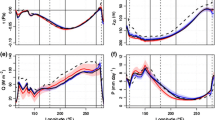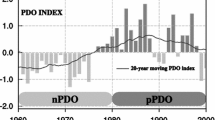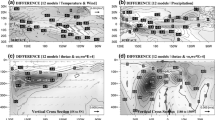Abstract
In this study, a Bjerknes stability (BJ) index, proposed by Jin et al. (2006), is adopted to assess the overall stability of El Niño and Southern Oscillation (ENSO) in state-of-the-art coupled models. The twentieth and twenty-first century simulations of 12 coupled models among the coupled model intercomparison project phase 3 models used in the intergovernmental panel on climate change forth assessment report demonstrate a significant positive correlation between ENSO amplitude and ENSO stability as measured by the BJ index. The simulations also show a diversity of behavior regarding the ENSO stability among the coupled models, which can be attributed to different mean state and sensitivity of an oceanic and atmospheric response to wind and SST forcing from model to model. When respective components of the BJ index obtained from the coupled models are compared with those from observations, it is revealed that most coupled models underestimate the thermodynamic damping effect and the positive effect of the zonal advective and thermocline feedback. Under increased CO2 induced warm climate, changes, relative to the twentieth century simulations, in the damping and feedback terms responsible for the ENSO stability measured by the BJ index can be linked to mean state changes and associated atmospheric and oceanic response sensitivity changes. There is a clear multi-model trend in the damping terms and positive zonal advective feedback, thermocline feedback, and Ekman feedback terms under enhanced greenhouse gas conditions. However, the various behavior among the coupled models in competition between the positive feedback and negative damping terms in the BJ index formula prevent the formation of a definitive conclusion regarding future projections of ENSO stability using the current coupled models.














Similar content being viewed by others
References
AchutaRao K, Sperber KR (2006) ENSO simulation in coupled ocean-atmosphere models: are the current models better? Clim Dyn. doi:10.1007/s00382-006-0119-7
Gordon HB et al (2002) The CSIRO Mk3 climate system model. Technical report 60, CSIRO Atmospheric Research, Aspendale, Victoria, Australia, p 134
Marti O et al (2005) The new IPSL climate system model: IPSL-CM4. Technical report, Institut Pierre Simon Laplace des Sciences de l’Environment Global, IPSL, Case 101, Paris, France
Salas-Melia D et al (2005) Description and validation of the CNRM-CM3 global coupled model. CNRM Working Note 103, 36
An S-I (2008) Interannual variations of the tropical ocean instability wave and ENSO. J Clim 21:3680–3686
An S-I (2009) A review of interdecadal changes in the nonlinearity of the El Nino-Southern oscillation. Theor Appl Climatol 92:29–40
An S-I, Jin F-F (2004) Nonlinearity and asymmetry of ENSO. J Clim 17:2399–2412
Battisti DS, Hirst AC (1989) Interannual variability in a tropical atmosphere-ocean model: influence of the basic state, ocean geometry and nonlinearity. J Atmos Sci 46:1687–1712
Bejarano L, Jin F-F (2008) Coexistence of equatorial coupled modes of ENSO. J Clim 21:3051–3067
Bjerknes J (1969) Atmospheric teleconnections from the equatorial Pacific. Mon Wea Rev 97:163–172
Cane MA (2004) The evolution of El Niño, past and future. Earth Planet Sci Lett 230:227–240
Carton JA, Giese BS (2008) A reanalysis of ocean climate using simple ocean data assimilation (SODA). Mon Wea Rev 136:2999–3017
Collins M (2000a) The El Niño-Southern oscillation in the second Hadley centre coupled model and its response to greenhouse warming. J Clim 13:1299–1312
Collins M (2000b) Understanding uncertainties in the response of ENSO the greenhouse warming. Geophys Res Lett 27:3509–3512
Collins M et al (2006) The community climate system model version 3 (CCSM3). J Clim 19:2122–2143
Davey MK et al (2002) STOIC: a study of coupled model climatology and variability in tropical ocean regions. Clim Dyn 18:403–420
Delworth TL et al (2006) GFDLs CM2 global coupled climate models. Part I: formulation and simulation characteristics. J Clim 19:643–674
Eisenman I, Yu L, Tziperman E (2005) Westerly wind bursts: ENSO’s tail rather than the dog? J Clim 18:5224–5238
Fang YJ, Chiang CH, Chang P (2008) Variation of mean sea surface temperature and modulation of El Niño-Southern oscillation variance during the past 150 years. Geophys Res Lett 35:L14709. doi:10.1029/2008GL033761
Fedorov AV (2002) The response of the coupled tropical-atmosphere to westerly wind bursts. Q J R Meteorol Soc 128:1–23
Fedorov AV, Philander SGH (2001) A stability analysis of tropical ocean-atmosphere interactions: bridging measurements and theory for El Niño. J Clim 14:3086–3101
Guilyardi E (2006) El Niño-mean state-seasonal cycle interactions in a multi-model ensemble. Clim Dyn 26:329–348. doi:10.1007/s00382-005-0084-6
Guilyardi E, Gualdi S, Slingo J, Navarra A, Delecluse P, Cole J, Madec G, Roberts M, Latif M, Terray L (2004) Representing El Niño in coupled-atmosphere GCMs: the dominant role of the atmospheric component. J Clim 17:4623–4629
Guilyardi E, Wittenberg A, Fedorov A, Collins M, Wang C, Capotondi A, van Oldenborgh GJ, Stockdale T (2009a) Understanding El Niño in ocean-atmosphere general circulation models: progress and challenges. Bull Am Meteorol Soc 90:325–340
Guilyardi E, Braconnot P, Jin F-F, Kim ST, Kolasinski M, Li T, Musat I (2009b) Atmosphere feedbacks during ENSO in a coupled GCM with a modified atmospheric convection scheme. J Clim 22:5698–5718
Hasumi H, Emori S (eds) (2004) K-1 coupled model (MIROC) description. K-1 Tech. Rep. 1, Center for Climate System Research, University of Tokyo, 34
Jin F-F (1997) An equatorial ocean recharge paradigm for ENSO. Part I: conceptual model. J Atmos Sci 54:811–829
Jin F-F, An S-I, Timmermann A, Zhao J (2003) Strong El Niño events and nonlinear dynamical heating. Geophys Res Lett 30:1120. doi:10.1029/2002GL016356
Jin F-F, Kim ST, Bejarano L (2006) A coupled-stability index of ENSO. Geophys Res Lett 33:L23708. doi:10.1029/2006GL027221
Jin F-F, Lin L, Timmermann A, Zhao J (2007) Ensemble-mean dynamics of the ENSO recharge oscillator under state-dependent stochastic forcing. Geophys Res Lett 34:L03807. doi:10.1029/2006GL027372
Jungclaus J et al (2006) Ocean circulation and tropical variability in the coupled model ECHAM5/MPI-OM. J Clim 19:3952–3972
Kim S-J, Flato GM, de Boer GJ, McFarlane NA (2002) A coupled climate model simulation of the last glacial maximum. Part I: transient multi-decadal response. Clim Dyn 19:515–537
Knutson TR, Manabe S (1994) Impact of increased CO2 on simulated ENSO-like phenomena. Geophys Res Lett 21:2295–2298
Latif M et al (2001) ENSIP: The El Nino simulation intercomparison project. Clim Dyn 18:255–276
Lin J-L (2007) The double-ITCZ problem in IPCC AR4 coupled GCMs: ocean-atmosphere feedback analysis. J Clim 20:4497–4524
Lloyd JE, Guilyardi E, Weller H, Slingo J (2009) The role of atmosphere feedbacks during ENSO in the CMIP3 models. Atmos Sci Lett 10:170–176
Meehl GA, Gent PR, Arblaster JM, Otto-Blinesner BL, Brady EC, Craig A (2001) Factors that affect the amplitude of El Niño in global coupled climate models. Clim Dyn 17:515–526
Meehl GA, Teng H, Branstator G (2006) Future changes of El Niño in two global coupled climate models. Clim Dyn 26:549–566
Merryfield WJ (2006) Changes to ENSO under CO2 doubling in a multimodel ensemble. J Clim 19:4009–4027
Münnich M, Cane MA, Zebiak SE (1991) A study of self-excited oscillations of the tropical ocean–atmosphere system. Part II: nonlinear cases. J Atmos Sci 48:1238–1248
Nakicenovic N, Swart R (eds) (2000) Special report on emissions scenarios. A special report of working group III of the Intergovernmental panel on climate change. Cambridge University Press, Cambridge, UK and New York, p 570
Neelin JD, Battisti DS, Hirst AC, Jin F-F, Wakata Y, Yamagata T, Zebiak SE (1998) ENSO theory. J Geophys Res 103:14261–14290
Philip SY, van Oldenborgh GJ (2006) Shifts in ENSO coupling processes under global warming. Geophys Res Lett 33:L11704. doi:10.1029/2006GL026196
Simmons AJ, Gibson JK (2000) The ERA-40 project plan. Technical report, ERA-40 project report series 1, ECMWF, Reading, United Kingdom, 63
Smith TM, Reynolds RW (2003) Extended reconstruction of global sea surface temperatures based on COADS data (1854–1997). J Clim 16:1495–1510
Suarez MJ, Schopf PS (1988) A delayed action oscillator for ENSO. J Atmos Sci 45:3283–3287
Sun D-Z, Yu Y, Zhang T (2009) Tropical water vapor and cloud feedbacks in climate models: a further assessment using coupled simulations. J Clim 22:1287–1304
Timmermann A, Oberhuber J, Bacher A, Esch M, Latif M, Roeckner E (1999) Increased El Niño frequency in a climate model forced by future greenhouse warming. Naturalium 398:694–697
Van Oldenborgh GJ, Philip SY, Collins M (2005) El Nino in a changing climate: a multi-model study. Ocean Sci 1:81–95
Vecchi GA, Soden BJ (2007) Global warming and the weakening of the tropical circulation. J Clim 20:4316–4340
Wang C, Picaut J (2004) Understanding ENSO physics, A review. In: Wang C, Xie S-P, Carton JA (eds), Earth’s climate: the ocean-atmosphere interaction, AGU Geophysical Monograph Series, 147:21–48
Yu Y, Zhang X, Guo Y (2004) Global coupled ocean atmosphere general circulation models in LASG/IAP. Adv Atmos Sci 21:444–455
Yukimoto S, Noda A (2002) Improvements in the meteorological research institute global ocean-atmosphere coupled GCM (MRI-CGCM2) and its climate sensitivity. Technical report 10, NIES, Japan, 8
Zavala-Garay J, Moore AM, Perez CL, Kleeman R (2003) The response of a coupled model of ENSO to observed estimates of stochastic forcing. J Clim 16:2827–2842
Zavala-Garay J, Zhang C, Moore AM, Kleeman R (2005) The linear response of ENSO to the Madden-Julian oscillation. J Clim 18:2441–2459
Zebiak SE, Cane MA (1987) A model El Niño-Southern oscillation. Mon Wea Rev 115:2262–2278
Zelle H, van Oldenborgh GJ, Burgers G, Dijkstra H (2005) El Niño and greenhouse warming: results from ensemble simulations with the NCAR CCSM. J Clim 18:4669–4683
Acknowledgments
This research is supported by NSF grants ATM 0652145 and ATM 0650552 and NOAA grants GC01-229. The authors thank Drs. Eric Guilyardi, Axel Timmermann and Shang-Ping Xie and anonymous reviewers for their valuable comments and May Izumi for her careful editing of the manuscript. We acknowledge the modeling groups for making their model output available for analysis, the Program for Climate Model Diagnosis and Intercomparison (PCMDI) for collecting and archiving this data, and the WCRP’s Working Group on Coupled Modelling (WGCM) for organizing the model data analysis activity. The WCRP CMIP3 multi-model dataset is supported by the Office of Science, US Department of Energy.
Author information
Authors and Affiliations
Corresponding author
Rights and permissions
About this article
Cite this article
Kim, S.T., Jin, FF. An ENSO stability analysis. Part II: results from the twentieth and twenty-first century simulations of the CMIP3 models. Clim Dyn 36, 1609–1627 (2011). https://doi.org/10.1007/s00382-010-0872-5
Received:
Accepted:
Published:
Issue Date:
DOI: https://doi.org/10.1007/s00382-010-0872-5




